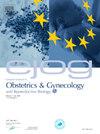宫颈机能不全妇女的宫颈环扎与宫颈塞:多中心、开放标签、随机对照试验[CEPEIC 试验]
IF 1.5
Q3 OBSTETRICS & GYNECOLOGY
European Journal of Obstetrics and Gynecology and Reproductive Biology: X
Pub Date : 2024-10-11
DOI:10.1016/j.eurox.2024.100347
引用次数: 0
摘要
宫颈机能不全占早产的 8%。子宫颈环扎术和子宫颈环扎术被认为是预防早产的方法。我们比较了这两种干预方法在降低曾因宫颈机能不全而早产或因宫颈短小而早产的妇女的早产率方面的效果。参与者为曾因宫颈机能不全导致早产的单胎妊娠妇女,或曾因宫颈机能不全导致早产且宫颈短(小于 25 毫米)的本次妊娠妇女。妇女被随机[1:1]分配到宫颈环扎术或子宫环扎术中。主要结果是评估宫颈环扎术与宫颈环扎术对比试验的可行性,以预防宫颈机能不全妇女在 34 周前发生早产。作为次要结果,我们研究了在宫颈机能不全的妇女中使用宫颈栓与宫颈环扎的发病率,并评估了在这些妇女中使用这两种装置的经济影响。样本量是根据我们可能招募的估计人群计算的:60 名妇女,每组 30 人,以确定妊娠 34 周的早产率是否会像使用宫颈环扎器的结果一样,在栓塞组从 34% 降低到至少 27%。结果 我们的研究没有观察到妊娠 34 周早产率的明显差异,尽管该研究的力量不足以检测出这些差异[妊娠 34 周早产率的相对风险 [RR] 为 0.8 [95 % CI: 0.31-2.09, p = 0.888]。两种装置的产科和围产期并发症发生率相似[两组均为 15 例,占 50% [RR;0.6-1.68;P = 1]。宫颈栓塞的副作用少于环扎术[与环扎术相比,宫颈栓塞组插入时出血较少,1 例 vs 14 例,p < 0.001;与环扎术相比,宫颈栓塞组取出时疼痛较少,14 例 vs 22 例,p = 0.042;出血较少,2 例 vs 10 例,p = 0.027]。宫颈环扎器在插入和取出时的副作用均少于环扎器。宫颈环扎术的副作用比陶瓷环扎术少。本文章由计算机程序翻译,如有差异,请以英文原文为准。
Cervical cerclage vs cervical pessary in women with cervical insufficiency: A multicentric, open-label, randomised, controlled pilot trial [the CEPEIC trial]
Objective
Cervical insufficiency accounts for 8 % of preterm births. Pessary and cerclage are considered preventive approaches for preterm birth. These interventions were compared in terms of reducing the prematurity rate in women with previous preterm birth, due to cervical insufficiency or due to having a short cervix in their current pregnancy.
Methods
This was a prospective, multicentric, open-label, randomised, pilot, controlled trial. Participants were women with singleton pregnancies who had previous preterm birth caused by cervical insufficiency or previous preterm birth and a short cervix [≤ 25 mm] in their current pregnancy. Women were randomised [1:1] to either cerclage or pessary. The primary outcome was to assess the feasibility of a trial on cervical pessary vs. cerclage to prevent preterm birth before 34 weeks in women with cervical insufficiency. As a secondary outcome, we studied the morbidity rate of the pessary versus the cerclage in women with cervical insufficiency and assessed the financial impact of using both devices in these women. The sample size was calculated based on the estimated population that we could potentially recruit: 60 women, 30 for each group, to ascertain whether the rate of preterm birth < 34 weeks of gestation may be reduced from 34 % to at least 27 % in the pessary group, as in the results obtained with the cerclage.
Results
No significant differences in preterm birth < 34 weeks of gestation were observed in our study, although it was underpowered to detect these differences [the relative risk [RR] of PB < 34 weeks of gestation was 0.8 [95 % CI: 0.31–2.09, p = 0.888]. The rates of obstetric and perinatal complications were similar for both devices [15 cases in both groups, 50 % of cases [RR; 0.6–1.68; p = 1]. Cervical pessary had fewer secondary effects than the cerclage [less bleeding at insertion in the pessary group compared with cerclage, 1 case vs 14 cases, p < 0.001; less pain at removal in the pessary group compared with cerclage, 14 vs 22 cases. p = 0.042 and less bleeding, 2 cases vs. 10 cases, p = 0.027].
Conclusions
Pessary does not seem less effective than cerclage, although these findings need to be confirmed in a larger randomised controlled trial. Pessary had fewer secondary effects than cerclage both at insertion and removal.
Sinopsis
Cervical pessary does not seem to be less effective than cerclage. Cervical pessary had fewer secondary effects than cerclage.
求助全文
通过发布文献求助,成功后即可免费获取论文全文。
去求助
来源期刊

European Journal of Obstetrics and Gynecology and Reproductive Biology: X
Medicine-Obstetrics and Gynecology
CiteScore
2.20
自引率
0.00%
发文量
31
审稿时长
58 days
 求助内容:
求助内容: 应助结果提醒方式:
应助结果提醒方式:


